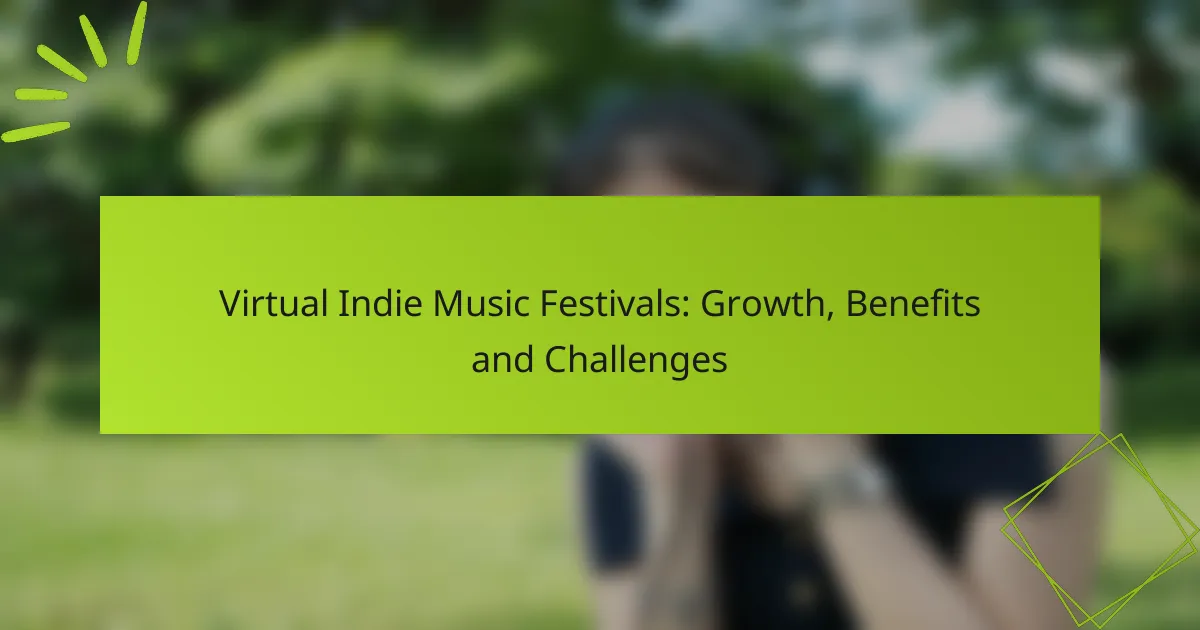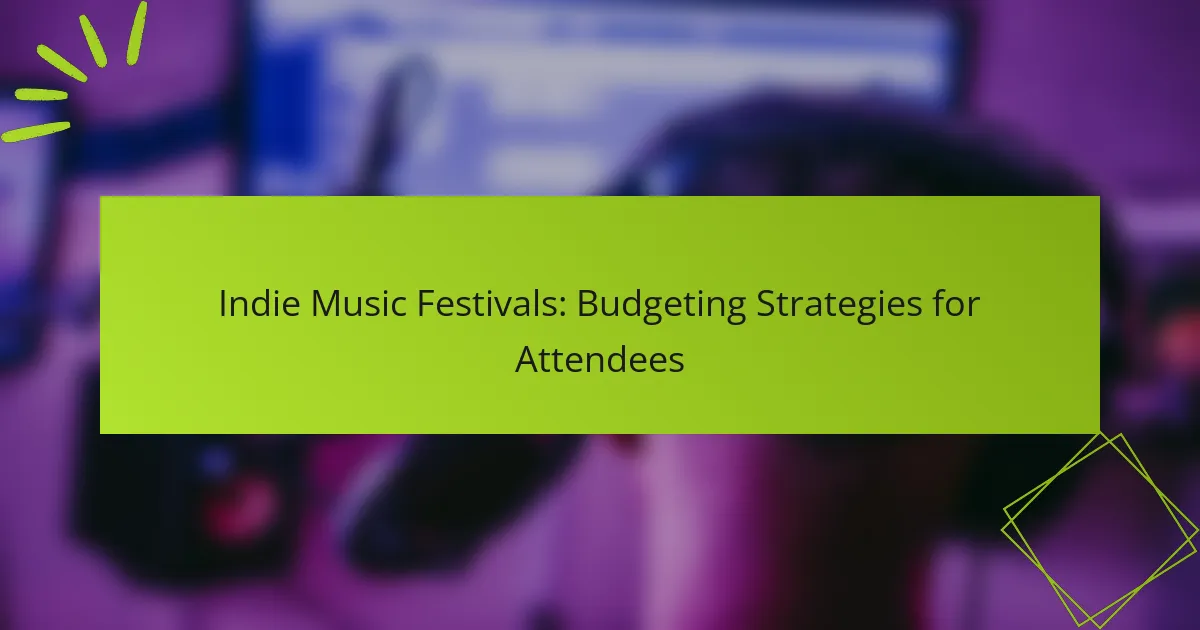Virtual indie music festivals are rapidly gaining popularity, driven by enhanced accessibility and the proliferation of digital platforms. These events not only enable artists to connect with larger audiences but also offer fans the chance to enjoy live music from the comfort of their homes. While they present significant advantages such as cost-effectiveness and inclusivity, organizers must also navigate challenges like technical difficulties and competition with traditional festivals to ensure a successful experience.
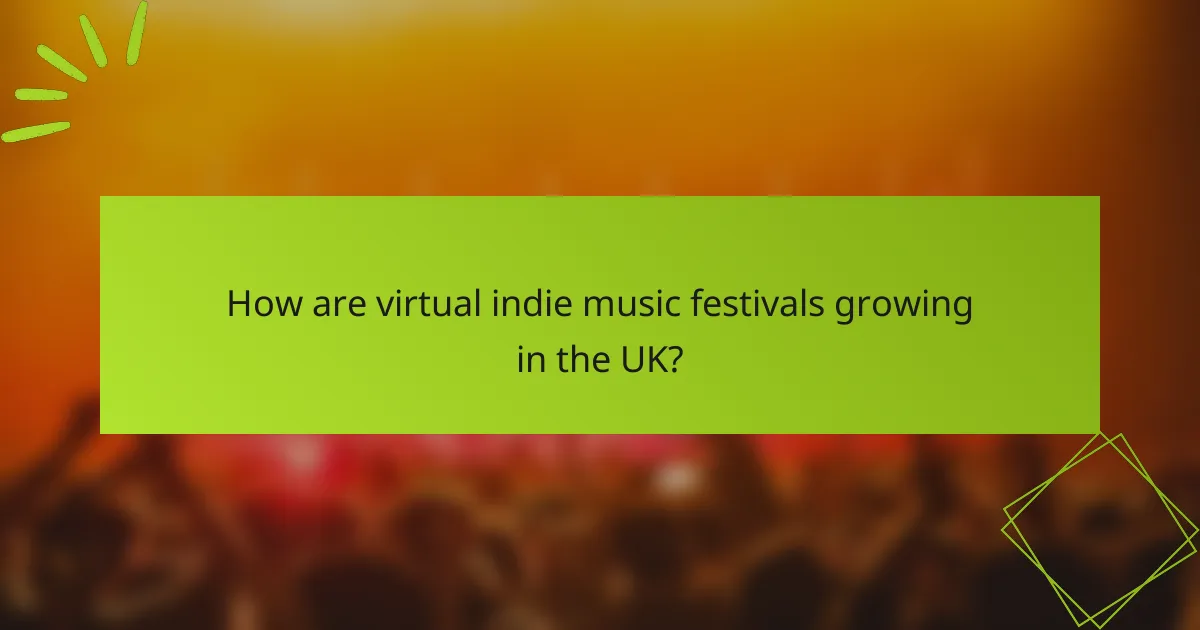
How are virtual indie music festivals growing in the UK?
Virtual indie music festivals in the UK are experiencing significant growth due to increased accessibility and the rise of digital platforms. These festivals allow artists to reach wider audiences while providing fans with unique experiences from the comfort of their homes.
Increased online engagement
The shift to virtual formats has led to heightened online engagement among music fans. Many festivals now utilize live streaming, interactive Q&A sessions, and virtual meet-and-greets to foster a sense of community. This engagement often translates to higher attendance rates compared to traditional in-person events.
Artists and organizers can track engagement metrics more easily, allowing them to tailor content and improve future events. For instance, real-time feedback during performances can guide setlists and enhance audience satisfaction.
Emergence of platforms like Bandcamp
Platforms such as Bandcamp have become vital for indie artists, enabling them to sell music directly to fans while hosting virtual festivals. These platforms often provide tools for artists to promote their work effectively, such as customizable pages and integrated streaming options.
By leveraging these platforms, festivals can offer exclusive content, merchandise bundles, and donation options, which can significantly increase revenue. This model allows artists to maintain a larger share of profits compared to traditional ticket sales.
Collaboration with social media influencers
Collaborating with social media influencers has become a key strategy for promoting virtual indie music festivals. Influencers can help amplify festival visibility by sharing content with their followers, driving ticket sales and engagement.
Effective partnerships often involve influencers participating in the festival, such as hosting segments or performing. This not only broadens the audience reach but also adds a layer of authenticity, as fans are more likely to engage with familiar faces.

What are the benefits of virtual indie music festivals?
Virtual indie music festivals offer numerous advantages, including broader audience engagement, reduced costs, and increased accessibility for diverse groups. These benefits make them an attractive option for both organizers and attendees, facilitating a unique experience in the music industry.
Wider audience reach
Virtual indie music festivals can attract a global audience, breaking geographical barriers that traditional festivals face. This expanded reach allows artists to connect with fans from various regions, increasing their visibility and potential fanbase.
For example, a festival based in Europe can easily draw attendees from North America, Asia, and beyond, resulting in a diverse mix of participants. Organizers should leverage social media and online marketing strategies to maximize their audience engagement.
Lower production costs
Hosting a virtual festival typically incurs lower production costs compared to in-person events. Expenses related to venue rental, physical infrastructure, and on-site staffing are significantly reduced or eliminated.
For instance, a virtual festival may only require investment in streaming technology and promotional efforts, allowing organizers to allocate funds towards artist compensation or innovative online experiences. This cost-effectiveness can lead to higher profit margins or more affordable ticket prices for attendees.
Accessibility for diverse audiences
Virtual indie music festivals enhance accessibility by allowing individuals with mobility challenges or those in remote areas to participate without the need for travel. This inclusivity fosters a sense of community among diverse audiences.
Additionally, organizers can consider offering features such as sign language interpretation, subtitles, or multiple language options to cater to a broader demographic. By prioritizing accessibility, festivals can create a welcoming environment for all music lovers.
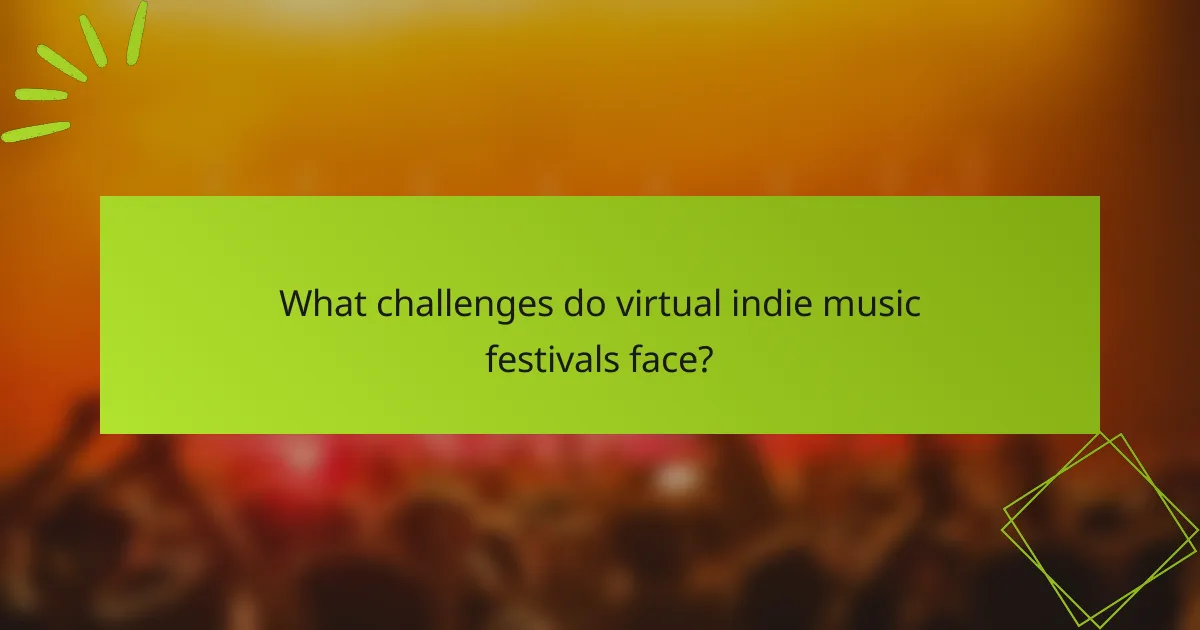
What challenges do virtual indie music festivals face?
Virtual indie music festivals encounter several challenges that can impact their success, including technical issues, monetization difficulties, and competition with traditional festivals. Addressing these challenges is crucial for organizers aiming to create engaging and profitable online experiences.
Technical issues and platform reliability
Technical issues can significantly disrupt the experience of virtual indie music festivals. Common problems include poor streaming quality, lag, and platform crashes, which can frustrate both artists and attendees. Ensuring a reliable platform with adequate bandwidth and backup systems is essential to minimize these risks.
Organizers should conduct thorough testing before the event, including stress tests to simulate high traffic. Choosing well-established streaming platforms with a track record of reliability can also help mitigate technical challenges.
Monetization difficulties
Monetizing virtual indie music festivals can be challenging due to the lack of traditional revenue streams like ticket sales and merchandise. Many festivals rely on donations, sponsorships, and virtual ticketing, which may not generate sufficient income. Creatively exploring multiple revenue sources is vital for financial sustainability.
Offering tiered ticket options, exclusive content, and merchandise bundles can enhance monetization efforts. Additionally, engaging sponsors who align with the festival’s ethos can provide financial support while promoting relevant products to attendees.
Competition with traditional festivals
Virtual indie music festivals face stiff competition from traditional in-person events, which often provide a more immersive experience. Attendees may prefer the atmosphere, social interactions, and unique settings of physical festivals, making it difficult for virtual events to attract large audiences. Highlighting unique features of virtual festivals is crucial to stand out.
To compete effectively, organizers should focus on creating interactive experiences, such as virtual meet-and-greets, Q&A sessions, and behind-the-scenes content. Emphasizing accessibility and affordability can also appeal to a broader audience, making virtual festivals an attractive alternative to traditional options.
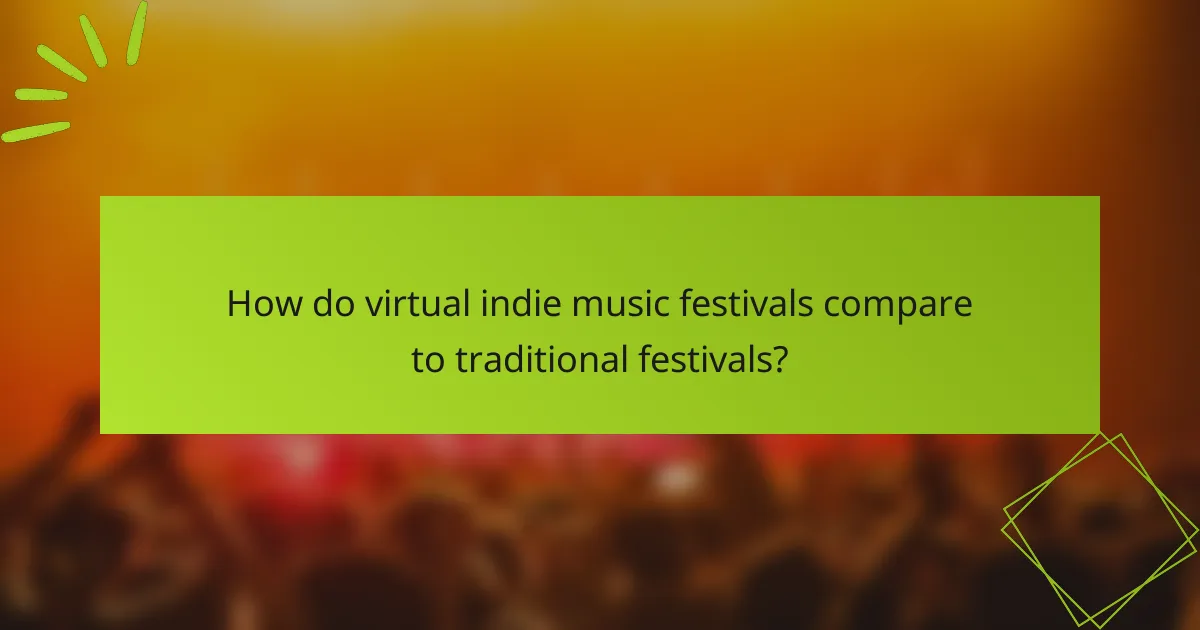
How do virtual indie music festivals compare to traditional festivals?
Virtual indie music festivals offer a distinct experience compared to traditional festivals, primarily through their accessibility and cost structure. While traditional festivals often require significant travel and accommodation expenses, virtual events can be attended from anywhere, reducing overall costs and expanding audience reach.
Cost-effectiveness
Virtual indie music festivals typically incur lower operational costs than traditional festivals. Expenses related to venue rental, staffing, and on-site logistics are minimized or eliminated, allowing organizers to allocate funds to artist compensation and marketing. This can lead to ticket prices that are more affordable for attendees, often ranging from free to a modest fee.
For attendees, the cost savings can be substantial. Without travel and accommodation costs, many fans can enjoy performances from multiple artists over several days without breaking the bank. This affordability can attract a broader audience, enhancing the festival’s overall success.
Audience engagement strategies
Engaging audiences at virtual indie music festivals requires innovative strategies that differ from in-person events. Organizers often utilize interactive elements such as live chats, Q&A sessions, and social media integration to foster a sense of community among attendees. These tools can enhance the experience and keep viewers invested throughout the festival.
Additionally, gamification techniques, such as virtual scavenger hunts or contests, can increase participation and excitement. By offering incentives like exclusive merchandise or meet-and-greet opportunities, festivals can encourage attendees to engage more deeply with the content and each other.
Artist exposure opportunities
Virtual indie music festivals provide artists with unique exposure opportunities that traditional festivals may not offer. Artists can reach a global audience without the limitations of physical space, allowing them to showcase their music to fans who may not have the means to travel. This can lead to increased streaming numbers and social media followers.
Moreover, virtual platforms often allow for recorded performances to be available post-festival, extending the reach of the artists’ work. This can create lasting connections with new fans and provide additional revenue streams through merchandise sales and digital downloads.
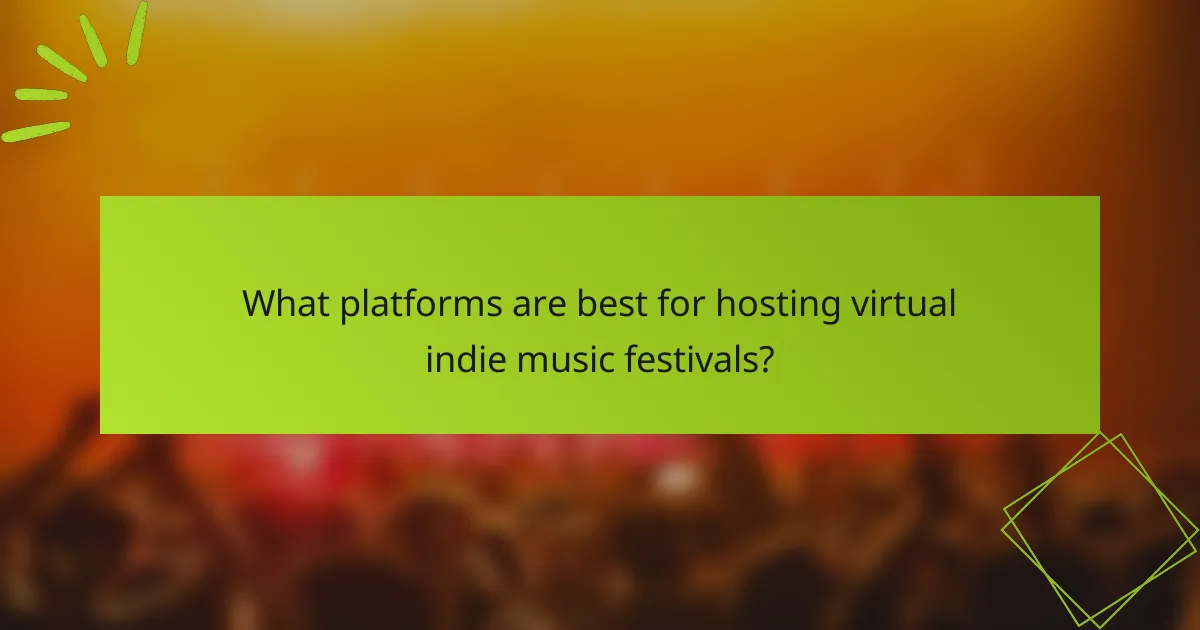
What platforms are best for hosting virtual indie music festivals?
Several platforms excel at hosting virtual indie music festivals, each offering unique features that cater to different needs. The best choice depends on the desired level of interaction, performance style, and audience engagement.
Zoom for live performances
Zoom is a popular choice for live performances due to its ease of use and robust video conferencing capabilities. Artists can perform in real-time, allowing for an intimate experience with the audience, who can interact through chat or video.
When using Zoom, consider the platform’s limitations on participant numbers and session duration, especially for larger festivals. A good practice is to schedule performances in shorter sets to maintain audience engagement and avoid technical issues.
Facebook Live for audience interaction
Facebook Live is ideal for fostering audience interaction during virtual indie music festivals. It allows artists to stream performances directly to their followers, enabling real-time comments and reactions, which enhances the communal experience.
To maximize engagement on Facebook Live, artists should promote their events in advance and encourage viewers to share the stream. Utilizing features like polls and Q&A sessions can further enhance interaction and keep the audience invested.
Twitch for gaming and music integration
Twitch is increasingly popular for indie music festivals, especially those targeting younger audiences who enjoy gaming and music together. The platform supports live streaming with interactive elements, allowing artists to engage with fans through chat and gaming features.
When hosting on Twitch, consider incorporating gaming elements or themed events to attract a broader audience. Regularly interacting with viewers during performances can help build a loyal following and create a vibrant community around the festival.

What are the future trends for virtual indie music festivals?
Future trends for virtual indie music festivals include increased interactivity, enhanced technology integration, and a focus on sustainability. As technology evolves, these festivals are likely to offer more immersive experiences, allowing fans to engage with artists and each other in innovative ways.
Increased Interactivity
Virtual indie music festivals are moving towards greater interactivity, enabling fans to participate in real-time through live chats, polls, and Q&A sessions. This shift enhances the sense of community and connection, making audiences feel more involved in the event.
Platforms may incorporate features like virtual meet-and-greets or backstage access, allowing fans to interact directly with their favorite artists. This level of engagement can significantly boost ticket sales and fan loyalty.
Enhanced Technology Integration
Advancements in technology will play a crucial role in shaping the future of virtual indie music festivals. Expect to see improvements in streaming quality, augmented reality (AR), and virtual reality (VR) experiences that create more immersive environments.
For instance, using VR headsets, attendees can experience a festival as if they were physically present, walking through a virtual venue and interacting with other fans. This technology may also allow for unique visual effects that enhance performances.
Focus on Sustainability
As environmental concerns grow, virtual indie music festivals are likely to emphasize sustainability. By reducing the carbon footprint associated with travel and physical venues, these festivals can appeal to eco-conscious audiences.
Organizers may implement practices such as digital ticketing, virtual merchandise, and partnerships with eco-friendly brands. This focus not only attracts a dedicated audience but also sets a precedent for future events in the music industry.
